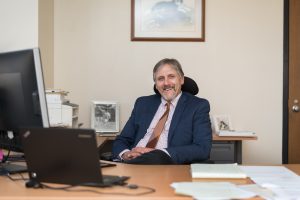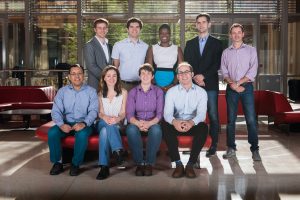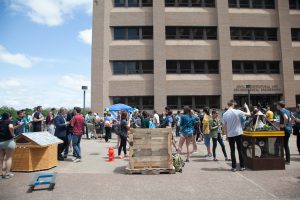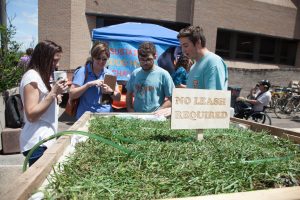Richard L. Corsi has served as chair of the Department of Civil, Architectural and Environmental Engineering at The University of Texas at Austin since 2013. He is stepping down to focus on his research and teaching in the area of indoor air quality. We sat down with him to discuss what he has learned, what he has enjoyed and what he is going to miss most about being department chair.
What would you consider to be your greatest successes as department chair?
I am proud of several accomplishments: Advancing the department’s strategic vision and plan and facilitating our early career faculty members’ ownership of that vision. They are helping to push the plan forward and build it. A plan is just a plan unless faculty help with follow-through, and I am very proud that is happening.
Finalizing and adopting a master schedule for undergraduate students so that they can get the courses they need to graduate in four years.
Raising funds to renovate the third-floor spaces in our building. Now, there are more inspiring, state-of-the-art places for our students to learn, collaborate and study.
Hiring eight new faculty members. The young faculty members we have hired are inspiring teachers who infuse new ideas, tools and innovations that translate into our courses and the research we do. They help students make new connections and see across boundaries.
What have you learned after serving as department chair?
It became clear to me how amazing our staff is. They are the gears of the department; things get done because we have dedicated staff who make things happen.
I also recognized that every faculty member has different constraints and challenges and balances things in ways I could never imagine. Faculty members form a bit of a mosaic, their talents are diverse and focused. There is no ‘generic faculty member.’
What are your hopes for the future of the department?
One of the things I wanted to do as department chair was to start breaking down the traditional silos, the separate areas of civil engineering. If faculty and students can work together across disciplines, they can be more creative and innovative when solving problems. The early career faculty (nearly 20 assistant and associate professors) have a really strong desire to chip away at these silos. I hope they continue to be encouraged to stay a family of cross-disciplined engineers and teachers, and I hope that, as they grow in their careers, they will keep that with them. They will ultimately be the ones that break down the silos, and I have a lot of faith that they will do this.
You have led the implementation of the department’s strategic vision; how do you see this vision being implemented in the future?
The Strategic Vision Implementation Committee consists of assistant and associate professors who feel that they have a say about the future direction of the
department and who feel empowered to advance our strategic plan. I would like to see this group continue to stay engaged. We should also revisit the strategic vision and treat it as a living document that evolves depending on the needs of society, faculty and students. It may be that, 10 years from now, it looks nothing like it does today.
During your time as chair, you invited students to compete in three separate team projects. Can you comment on these three annual Chair’s Challenges?
I am very passionate about enhancing the undergraduate experience for students. I wanted to provide opportunities for students to be motivated, inspired and challenged to do things outside of the classroom, and that’s where the Chair’s Challenge comes in. I knew that not everyone would participate but that some students would think it is a cool idea and would be excited to do something extra, to problem solve and have a friendly competition with each other. I challenged the students to produce a video about the nexus of cities, water and energy and to produce a video about why they chose to become a civil, architectural or environmental engineer, but I was most excited about this year’s challenge — the design of a sustainable, resilient, healthy and aesthetically pleasing dog house. The students really got into it.
Are you eager to return to the classroom?
It is always great to be with students, and I enjoy teaching undergraduates the fundamentals of engineering. I am looking forward to getting back into the classroom and hoping to dedicate the remainder of my career to improving undergraduate education.
What is one of the best things you discovered while serving as department chair?
One of the things I have enjoyed most about being department chair is meeting alumni, whether at the university or out in the field. So many of our alumni are doing incredible things for the profession and, when they do great things and then tell people they are graduates from our department at UT Austin, it shines a big, positive light on the department. Our alumni mean a lot to our stature.
Our alumni are also so dedicated to the program and give back in many different ways. They hire our students, give financially to support our students and programs and show our students the various career paths that await them. We are so very fortunate that we have such amazing alumni.
What do you view as the department challenges for the next chair?
Collectively, our department is among the elite programs in the nation. We do great things and are capable of doing even greater things. One of the challenges for the next department chair will be how to reach that untapped potential.
I’d like to think that, 10 years from now the nation will turn to our department on a range of societal infrastructure issues and say “we need to go see what Texas thinks.” We have to find ways of becoming leaders of our discipline without taxing our community, everyone has personal lives and already works very hard. How can we restructure ourselves so we don’t cost people more time and resources but get to a place that is better than the great place we are at now?
Department professor and geotechnical engineer Robert Gilbert will begin his appointment as the next chair on Sept. 1, 2017.




